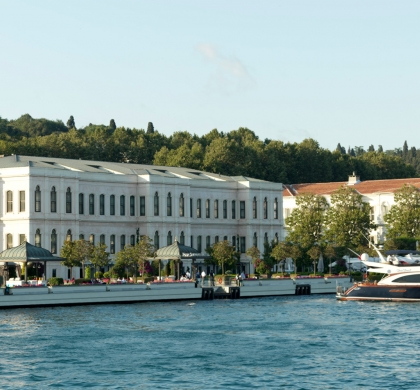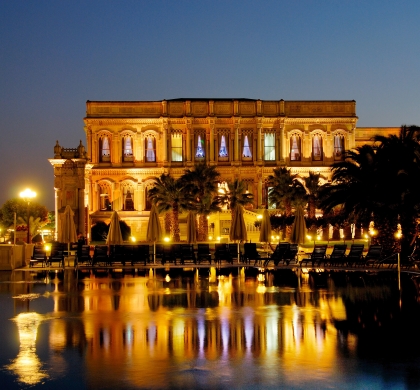Buy or gift a stand-alone digital subscription and get unlimited access to dozens of back issues for just £18.99 / $18.99 a year.
Please register at www.exacteditions.com/digital/cornucopia with your subscriber account number or contact subscriptions@cornucopia.net
Buy a digital subscription Go to the Digital EditionTime has stood still at the Kavafyan Konak, the oldest surviving mansion on the Bosphorus. Abandoned for 20 years in the village of Bebek, it is a rare example of the refinement and restraint of 18th-century Ottoman design. From a fresco of a formal garden – recalling the fashionable obsession with horticulture – to a trompel’oeil parasol rosette, original decorative details survive, decayed and faded but intact
The colonisation of the Bosphorus shoreline by the Ottoman elite began in the early 1700s, at the urging of Nevşelirli Damat İbrahim Pasha, Ahmed III’s enlightened grand vizier. The centuries-old small fishing village of Bebek, on the European shore, suddenly found itself the height of fashion, as the great and the good built wooden mansions on the hillsides and summer residences along the waterfront.
All but one of these delicate, birdcage-like houses have disappeared. The sole survivor is the Kavafyan Konak, built, presumably, by 1751 (the date chiselled into a fountain in the garden). The name of the first owner is lost to history. However, in the early 1800s, it came into the possession of an Armenian shipping magnate named Kavafyan, remaining in the same family until the death of his last descendants in 1998. Climbing the hill from the waterside, you will find the house and its terraced garden hidden away on a side street (Yoğurtçu Zülfü Sokak), from which it faces out over the Bosphorus, its back to Bebek hill.
The three-storey timber structure, with its austere façade, is set on massive stone footings. The entrance is at the back of the house through double doors in a high stone wall that open onto a courtyard. From the marble-floored entrance hall, a timber staircase leads to the first floor, laid out to a classical Turkish plan of central reception hall, or sofa, looking down to the blue waters of the Bosphorus on one side and up to the wooded hillside on the other. Off this light and spacious hall are four corner rooms.
For the architectural historian Doğan Kuban, it was such “clear geometry” and “luminous interior spaces” that made Turkish houses “closer to modern taste than anything created in Europe in the pre-modern period”. On the upper storey, the sofa floor plan is repeated, with the addition of a domed chamber, “the bride’s room” (gelin odası), which is embellished with gilded floral brushwork. A mural in an alafranga niche depicts a garden with fountains, balustrades, terraces, flower urns and orange trees at once fruiting and in bloom – fashionable French motifs scattered among traditional elements.
In an Ottoman household no expense was spared in preparing the bride’s room, to make a young girl feel happy in her new family. Apart from this delicately beautiful 19th-century room, the house is more or less in its original 18th-century state. Raised platforms (seki) under the windows are waiting to be turned into inviting seating areas with drifts of cushions. An upper tier of windows is another characteristic element of Ottoman architecture, and, though some have been blocked in, those that remain still have their stucco frames, with baroque detailing and possibly a few handmade panes. Ceilings are decorated with classical lozenge-patterned latticework.
The panelled built-in cupboards (yüklük) in the wall facing the windows are also part of the original floor plan: the perfect storage area in which to keep beds during the day and to stow clothes and other possessions. Their doors are painted a lovely blue-green sage. In the bride’s room the original doors are missing. One imagines that they were irresistible and found a new home. One of the upstairs corner rooms has a lantern window in the exterior wall, which must have let sunlight into the room by day and candlelight into the street at night.
Brick and stone remains of the old kitchen and hamam are still found in the garden, but there is no apparent evidence of the stables and grooms’ quarters that must have been located there. In his Lettres sur la Grèce, l’Hellespont et Constantinople (1811), the French artist Antoine-Laurent Castellan writes of a visit to the admiral Hüseyin Pasha’s residence at Kasımpaşa: “We entered a beautiful salon whose walls were covered with painted and gilded woodcarving.”
Above the panelling was “a stucco frieze” with “scenes of the Bosphorus with its palaces, kiosks, mosques and gardens”. He could have been describing the Kavafyan Konak in its glory days. One of the last few surviving wooden houses in Istanbul and a fine example of 18th-century Ottoman vernacular architecture, it has been crying out for care and protection.
Born into a family of much-travelled artists, Joseph Schranz made his name in Ottoman Istanbul on the eve of the Crimean War with finely detailed, atmospheric panoramas of the Bosphorus. Admired by the Palace and by a new breed of intrepid tourist, he even trained a generation of Turkish artists to observe nature. Yet Schranz’s life in Turkey is an almost total mystery and his known works are tantalisingly rare
With her discoveries at Cnidus she was the first female archaeologist to become a household name. But Aphrodite was the undoing of Iris Love. By Rupert Scott. New York portrait by Jürgen Frank
The transformation of the Black Sea’s vast Kizilirmak Delta from lost cause to paradise regained is a miraculous reversal of fortunes. The ornithologist Emin Yoğurtcuoğlu recalls his early visits and introduces the dazzling birds of the delta, while the anthropologist Caterina Scaramelli pays homage to a way of life that can only benefit both man and nature. Photographs by Emin Yoğurtcuoğlu
Like many others, when I first visited the Kızılırmak Delta wetland conservation area, I felt as if I had personally just discovered it. It was the summer of 2012… Caterina Scaramelli on the Black Sea’s most precious delta
The photographer Mark Cator shares his vivid diary and images of a ride across ancient Phrygia
Prodigiously talented and duplicitous, Parvus Efendi was a larger-than-life writer, arms dealer, fixer and bon vivant. Norman Stone sizes up the grand capitalist who oiled the wheels of the Russian Revolution and ingratiated himself with the Young Turks
Beloved of birds and bees, prized by Ottoman sultans and Bourbon kings, pears are a particular joy eaten ripe from the tree. But cooking coaxes the flavour out of even those mass-market varieties grown for a long shelf life and ripened in cold storage




Cornucopia works in partnership with the digital publishing platform Exact Editions to offer individual and institutional subscribers unlimited access to a searchable archive of fascinating back issues and every newly published issue. The digital edition of Cornucopia is available cross-platform on web, iOS and Android and offers a comprehensive search function, allowing the title’s cultural content to be delved into at the touch of a button.
Digital Subscription: £18.99 / $18.99 (1 year)
Subscribe now